What is liftgate service? This guide explains how liftgate delivery works, its key benefits, costs, and when you absolutely need it for your freight.
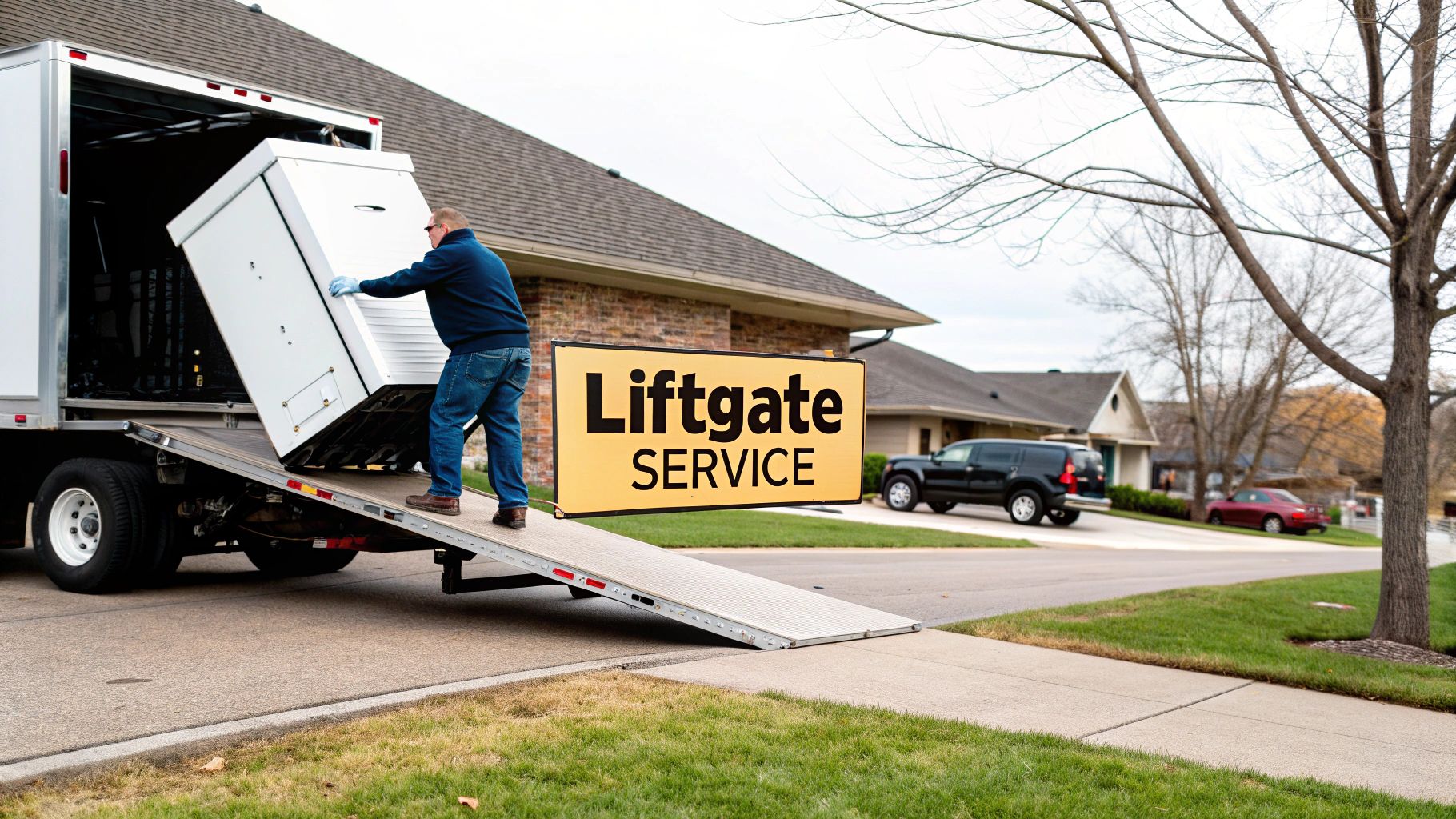
So, what exactly is a liftgate service? Think of it as a special delivery option where the truck comes with its own personal elevator. It’s a mechanical platform on the back that smoothly lowers heavy or bulky items from the truck bed to the ground, and can also lift them back up.
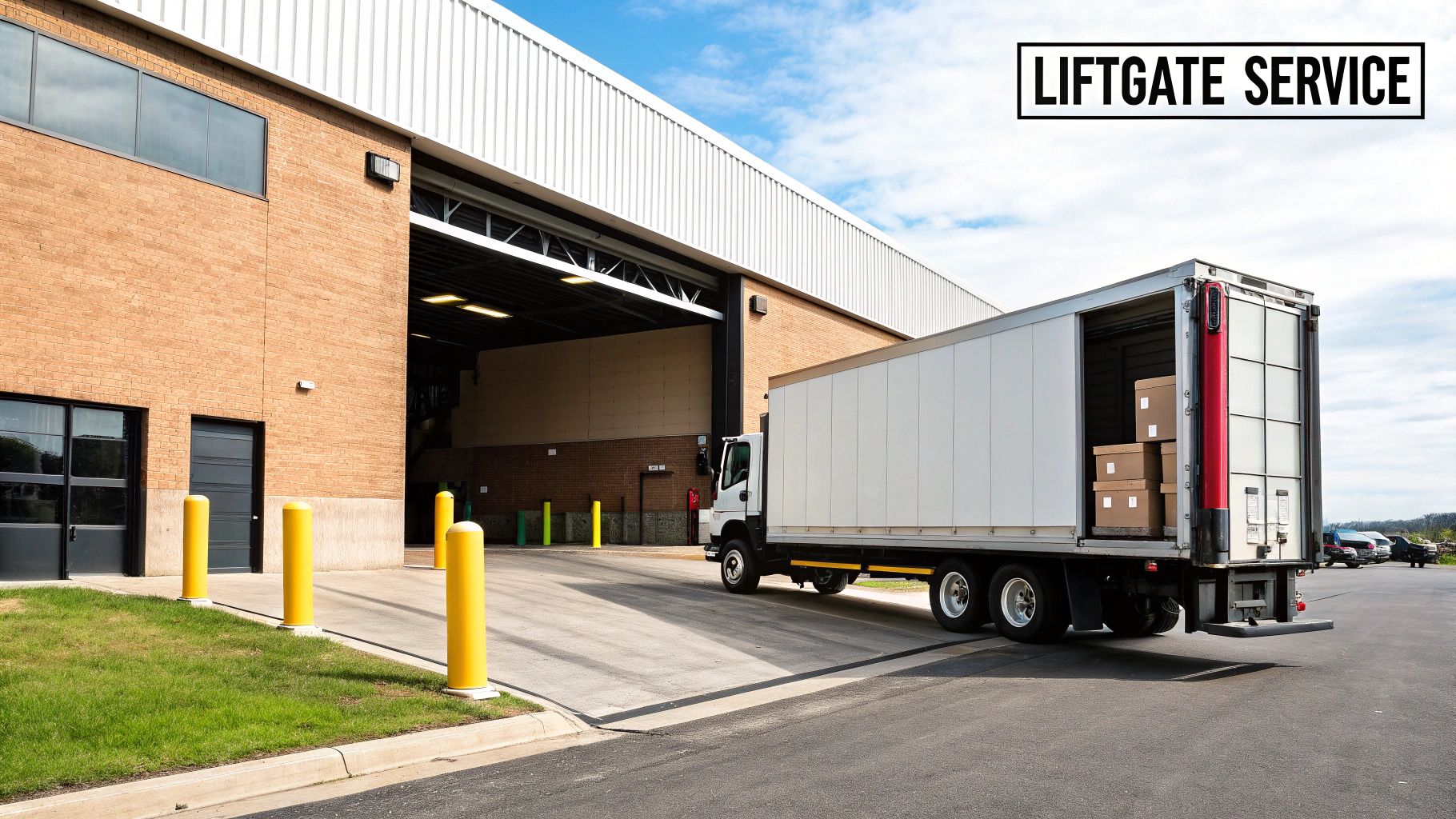
Picture this: you’ve ordered a massive, heavy piece of equipment, but your business doesn't have a raised loading dock or a forklift. How do you get it off the truck? That's the exact puzzle liftgate service solves. It acts as a crucial bridge when the pickup or delivery spot isn’t a fully equipped warehouse.
This service is a game-changer for certain locations, making it possible to ship just about anything to just about anywhere.
To give you a quick snapshot, here’s a simple breakdown of what liftgate service is all about.
This service is really about making freight accessible, no matter the destination.
While massive distribution centers are built with high loading docks, most places aren't. That’s where a liftgate becomes absolutely essential.
It’s a lifesaver for:
Basically, if there's no forklift or dock in sight, a liftgate is your go-to for a smooth, damage-free delivery.
A liftgate isn’t just a nice-to-have; it’s a critical tool for accessibility in the world of logistics. It ensures freight can move seamlessly from a commercial truck to ground level, opening up delivery possibilities far beyond the typical industrial park.
At its heart, a liftgate is designed to make loading and unloading heavy cargo much easier. But its benefits go beyond simple convenience. By using a liftgate, carriers can significantly cut down on the manual labor needed, often reducing loading times by around 30%. This is a huge win, especially for those crucial last-mile deliveries.
Even more importantly, it's a massive boost for safety. Proper use of a liftgate can help lower the risk of worker injuries by as much as 40%. If you’re interested in the data, you can read more about the impact of liftgates on the market and see just how much they contribute to safer operations.
To really get a feel for liftgate service, let's walk through a typical shipment from start to finish. It all begins when you first book your freight. This is actually the most important part of the whole process.
If you know your delivery spot doesn't have a proper loading dock or a forklift on site, you have to request a liftgate-equipped truck right from the get-go. Getting this one detail right sets the entire delivery up for a smooth landing, helping you sidestep those frustrating delays and surprise redelivery fees.
Once the truck pulls up to the destination, the driver takes charge. They’ll park the truck safely and then head for the liftgate controls, which are usually on the side of the truck or on a remote. The liftgate platform unfolds from its stowed position and is brought level with the truck bed.
Next, your freight is carefully positioned onto the platform. The driver makes sure everything is stable and secure before starting the descent.
With the push of a button, the hydraulic lift gently lowers your cargo all the way to the ground. This controlled, smooth movement is what liftgate service is all about—it protects the driver from injury and your goods from damage.
The final step is to move the freight off the platform and onto the curb, which completes the "curbside delivery." The whole thing is a great example of why knowing how to ship freight correctly from the start makes all the difference.
This graphic breaks down the three key steps of the liftgate process.
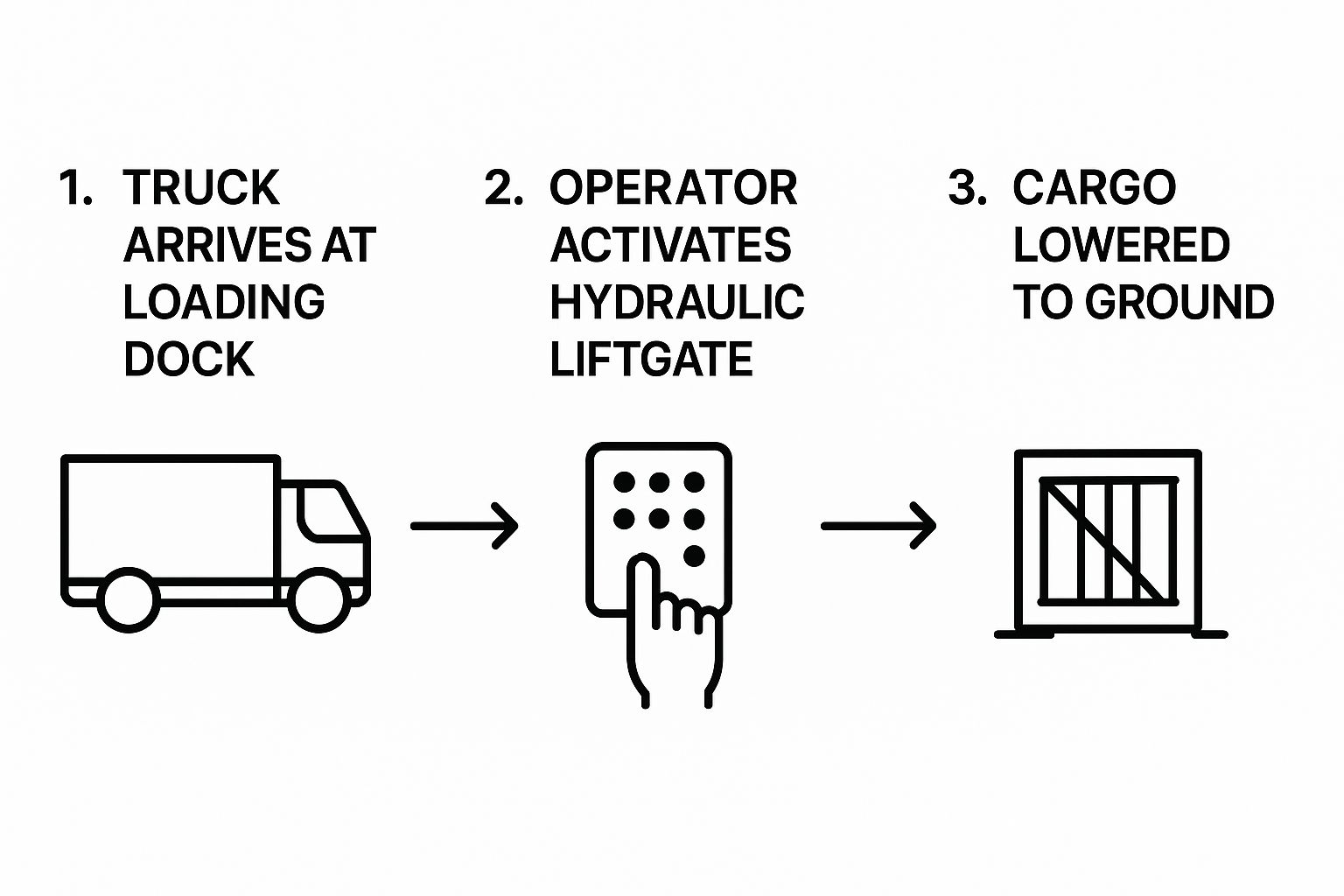
As you can see, it’s a simple flow: the truck arrives, the lift is activated, and the freight is safely delivered to the ground. It’s an elegant solution to a common logistics problem.
And the technology just keeps getting better. The hands-free power liftgate market was valued at $1.5 billion and is projected to hit $2.3 billion by 2033. This growth is all about the demand for safer and more convenient access on commercial trucks. You can dive deeper into these trends in the hands-free power liftgate market research.
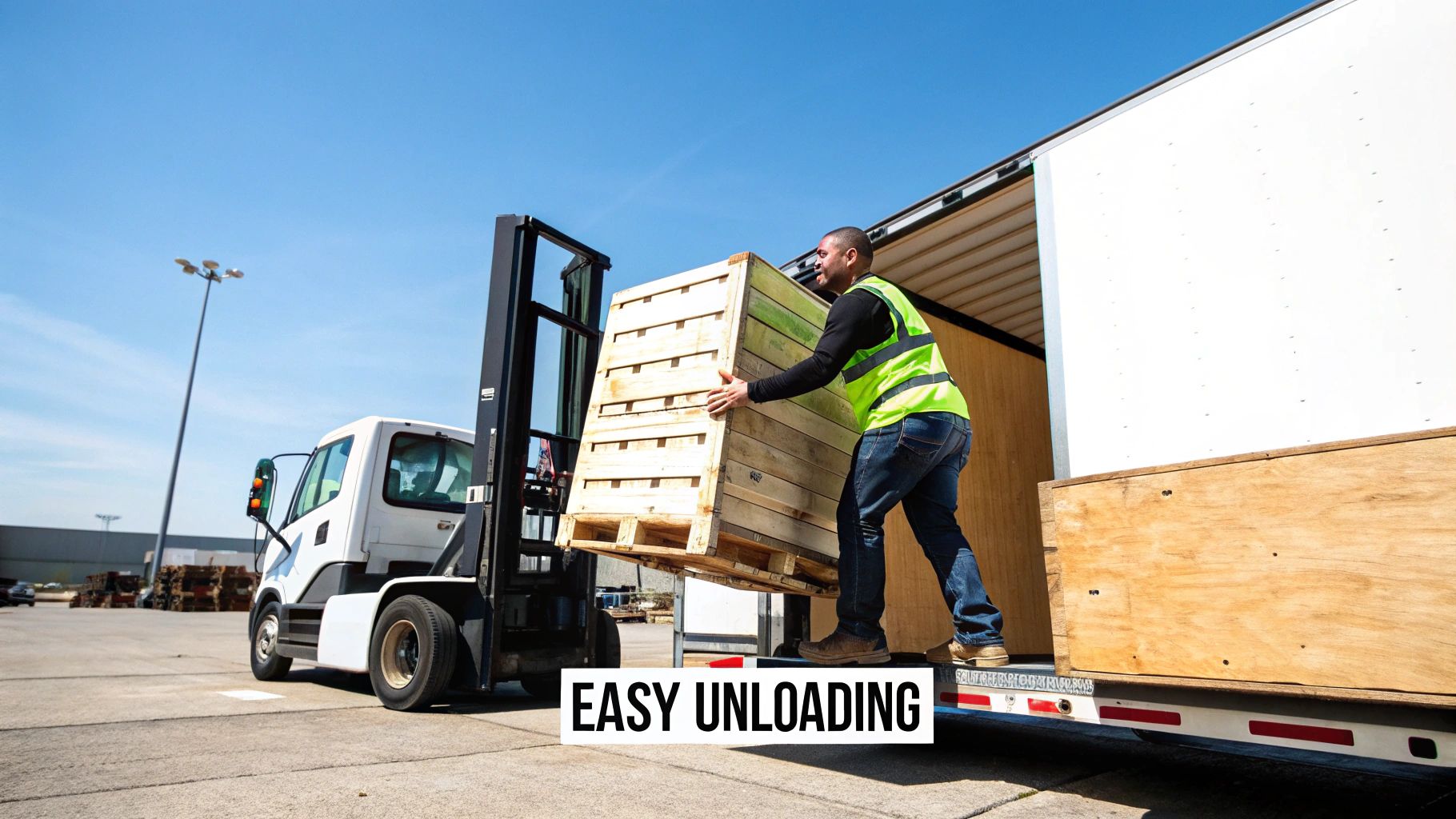
So, how do you know if you really need to tick the "liftgate required" box when booking your freight? The simple rule of thumb is "no loading dock, no forklift." But let's be honest, real-world shipping is rarely that simple. Knowing the specific situations where a liftgate is non-negotiable can save you a world of hurt later on.
Imagine this: you're shipping a heavy pallet, and you decide to skip the liftgate to save a few bucks. What happens? The truck arrives, the driver has no way to unload it, and your shipment gets sent right back to the terminal. You’re now on the hook for redelivery fees, your customer is frustrated by delays, and the risk of someone getting hurt or your freight getting damaged skyrockets. It's just not worth the gamble.
If your delivery location looks anything like the ones below, a liftgate isn't just a nice-to-have—it's essential.
Many of these shipments are perfect candidates for less-than-truckload shipping. You can learn more in our complete guide to LTL freight loads.
Key Takeaway: Forgetting to request a liftgate for a location without a dock isn’t a small oversight—it’s a logistical failure waiting to happen. It almost always results in the shipment being returned to the terminal, triggering extra fees and delays.
Finally, don't forget about places like hotels, schools, or convention centers. You might be sending a heavy trade show booth or AV equipment for an event. Never assume these venues have their own docks or forklifts ready for your delivery. Play it safe and book the liftgate.
Here is the rewritten section, designed to sound like an experienced human expert.
It's easy to look at a liftgate fee on a freight quote and think of it as just another cost to cut. But honestly, that’s a rookie mistake. Thinking about it that way misses the bigger picture.
A liftgate isn't just a piece of equipment; it's an investment in getting your shipment where it needs to go without headaches. The real value isn't just about moving a heavy box—it's about protecting your business, your timeline, and your reputation.
The most critical benefit is simply enhanced safety. Let's be real: trying to wrestle a 500-pound crate off the back of a truck without the right gear is a disaster waiting to happen. Someone could get seriously hurt, and your expensive cargo could easily end up smashed on the pavement.
A liftgate takes that risk right off the table. It’s like having an insurance policy against workplace injuries and damaged goods, which can save you a fortune in the long run.
Next up is greater efficiency. Picture this: your truck arrives at a small business or a residential address, but there's no loading dock. Without a liftgate, that driver is stuck. The shipment can't be unloaded, which means a failed delivery, a frustrated customer, and a hefty redelivery fee coming your way. A liftgate ensures the delivery happens right then and there, keeping your supply chain flowing smoothly.
Finally, it opens up a world of total accessibility. With a liftgate-equipped truck, you aren't limited to shipping only to warehouses and commercial facilities. Suddenly, your potential market includes:
It’s a game-changer. By making almost any address a viable delivery point, a liftgate service stops being a simple unloading tool and becomes a key to growing your business. It guarantees your freight can get to any customer, anywhere, safely and on the first try.
This kind of access means you never have to turn down a sale just because of a customer's location. That's how you expand your reach and find new opportunities.
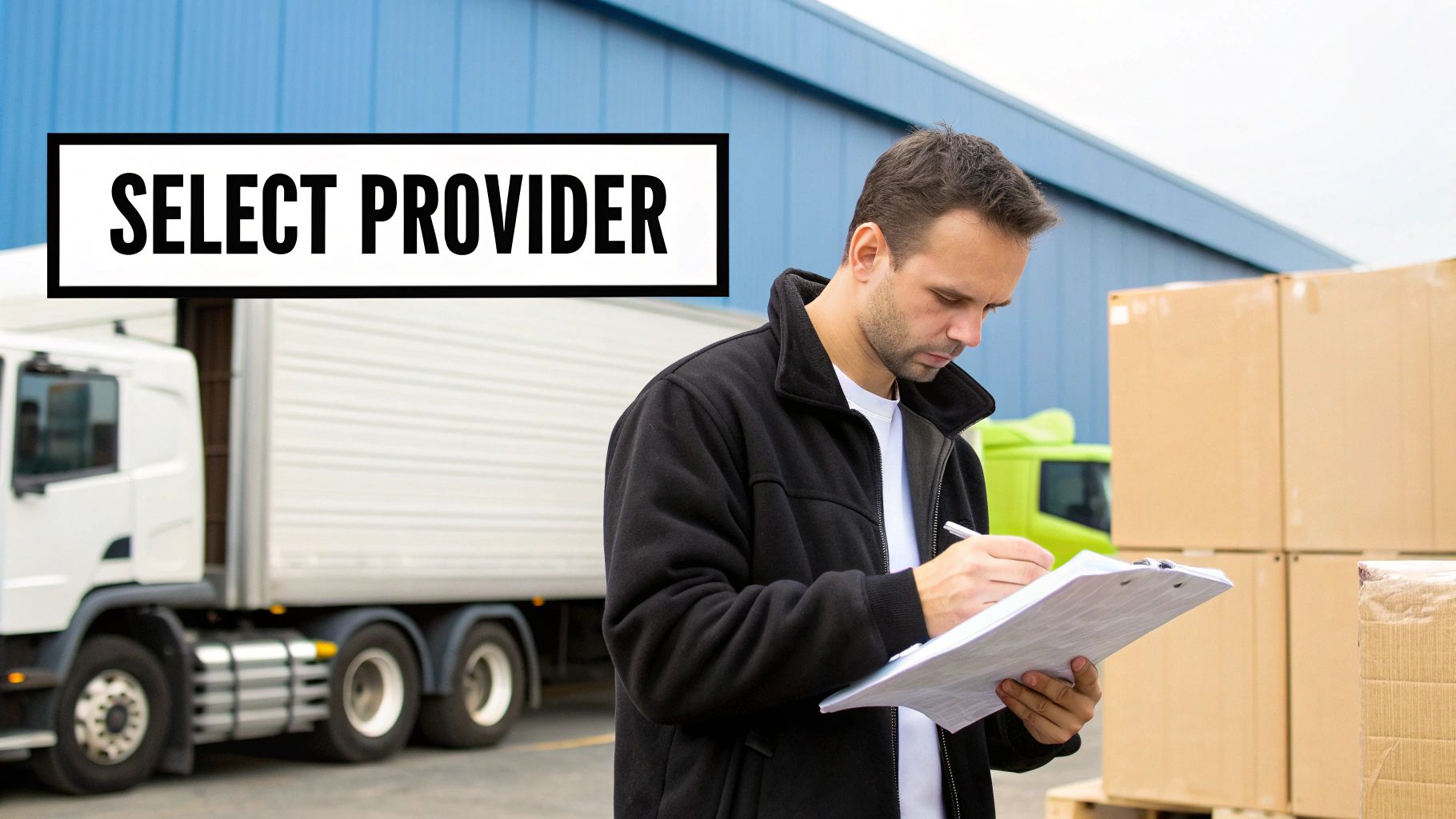
Let's talk about one of the most common surprises on a freight bill: the liftgate fee. Nobody likes seeing an extra charge, but it helps to think of this one less as a penalty and more as a fair price for a critical piece of equipment. It’s a service that prevents much bigger, more expensive headaches down the line.
The charge isn't just an arbitrary markup. It's there because equipping a truck with a powerful hydraulic lift is a serious investment for the carrier. These systems aren't just bolted on and forgotten; they need constant, thorough maintenance to keep them working safely and reliably. A broken liftgate means delays, missed deliveries, and potential accidents—all things that cost everyone time and money.
So, what are you really paying for when you see that line item? It’s pretty straightforward—you’re paying for the carrier’s cost to provide a specialized tool for a specific job.
Here’s a breakdown of what that fee typically covers:
Think of it this way: you’re essentially renting a mobile loading dock. The fee ensures the equipment is safe, functional, and ready to go when your shipment arrives. It’s a far better alternative than dealing with a failed delivery, re-delivery charges, and frustrated customers.
Factoring in this cost from the start is just smart planning. For a deeper dive into managing your shipping budget, check out our guide on how to reduce freight costs.
It's also interesting to look at the bigger picture. The entire automotive power liftgate market was valued at USD 2.4 billion and is expected to jump to a massive USD 9.3 billion by 2037. This incredible growth, which you can read more about in this market research report, proves just how valuable these systems have become for both commercial and personal use.
Even after getting the basics down, you might still have a few questions about how liftgate service works in the real world. That’s perfectly normal. Let's clear up some of the most common points that come up so you can book your next shipment with total confidence.
Think of this as the final check to make sure you've covered all your bases.
This is a big one, and the answer is a firm no. It's probably the most important distinction to get right. Standard liftgate service is strictly for "curbside delivery."
The driver's job is to get your freight from the inside of the truck safely to the ground. That’s it. They’ll place it at the curb or the end of the driveway. Moving it from there into your home, garage, or business is a completely different job. If you need that level of service, you have to ask for "Inside Delivery" or even "White Glove Service," which, as you can guess, come with their own costs.
Forgetting to book a liftgate when you need one can turn into a real headache, and an expensive one at that. If a truck shows up at a location without a loading dock or forklift, they simply can't unload the freight safely. The delivery will fail.
What happens next? The shipment gets hauled back to the carrier's local terminal. You'll then get hit with a bill for the failed delivery attempt, storage fees for your freight, and the cost of sending it back out on a truck that actually has a liftgate. It’s always, always cheaper and faster to just get it right the first time.
The rule of thumb in freight is to plan for the destination you have, not the one you wish you had. If there's no dock or forklift, ordering a liftgate isn't optional—it's essential for a successful delivery on the first attempt.
Absolutely. Every liftgate has its limits, and it's vital to know them before you book.
If your shipment is heavier or bigger than these specs, you have to tell your carrier upfront. They might have a truck with a heavy-duty liftgate or can figure out another solution to handle your oversized freight safely.
Not always. The need for a liftgate is entirely based on the equipment available at each specific location—the origin and the destination.
You can absolutely request the service for just one end of the trip. For instance, say you’re shipping from your warehouse (which has a dock) to a small retail shop (which doesn't). In that case, you'd only need to add liftgate service for the delivery. Just make sure to be crystal clear about the needs of both locations when you're getting your freight quote to avoid any surprises.